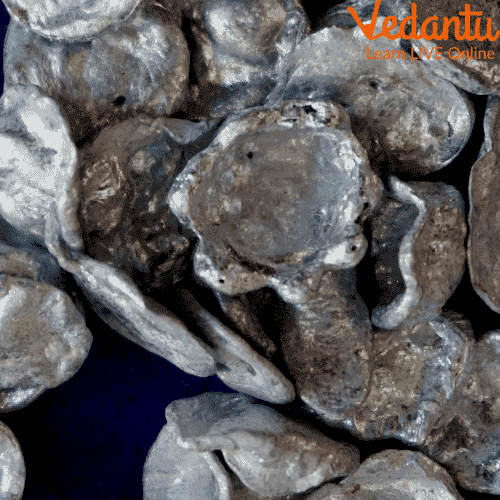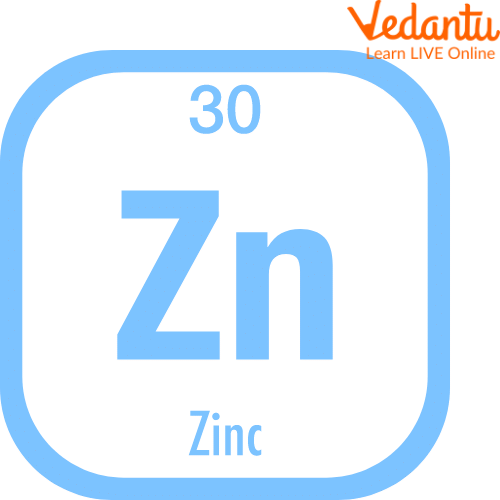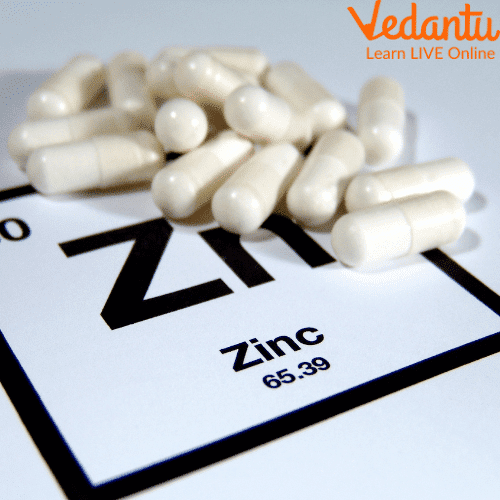




Introduction to Zinc
Whatever you see around yourself, maybe buildings, pipes, electronic gadgets and other objects are made from metal. But do you know which metal is used in all these materials? Well, it's zinc.

Zinc Metal
Zinc is a naturally occurring chemical element found on the earth's crust, especially in rocks. However, its small amounts are also found in the oceans and air. It is the 24th most abundant element on the planet. It plays an important role in producing metal-based products, medicines, etc.
In this article, we will discuss zinc atomic number, zinc atomic mass, symbol of zinc, properties of zinc, and uses of zinc in detail.
What is zinc in chemistry?
In chemistry, zinc is defined as a metal which does not exist in a free state. This means that you cannot see zinc metal as a whole like iron or gold, but in the form of compounds with other elements like steel or brass. According to the periodic table, the symbol of Zinc is Zn, and the zinc atomic number is 30. Also, zinc atomic mass is 65.38 units. As it is a metal, it exists in the solid state at room temperature but can change its form according to the change in temperature.

Zinc Symbol, Mass and Atomic Number
Properties of Zinc
Zinc has various physical and chemical properties. Let's discuss each in detail.

Zinc wire
Physical Properties
The physical properties of zinc include;
It is a metal found in combination with other metals and non-metals.
It is a solid transition metal.
It is brittle at room temperature and has a silvery-greyish appearance.
The boiling and melting points of zinc are 907°C and 419°C.
Its density is 7.14 grams per cm cubes.
Zinc is a good conductor of heat and electricity; hence, used in making electrical appliances.
It is ductile, which means it can be moulded into wires.
It becomes elastic and malleable above 100 degrees Celsius.
Above 200 degrees Celsius, it becomes a grey powder and loses its elasticity.
Chemical Properties
The chemical properties of zinc include;
It is highly reactive and reacts readily with air, thus resulting in a dull-grey coating on metals exposed in the environment.
It reacts with less reactive non-metals, oxygen, ammonia and its compounds.
It emits greenish-blue light when burnt.
It does not react directly with water. First, it reacts with the oxygen in the water vapour and forms zinc hydroxide.
Uses of Zinc
Zinc is used across various sectors ranging from manufacturing to healthcare. Some of its uses are;

Zinc Tablets
Industrial Uses
It is used in galvanising metals like iron to prevent them from rusting and corrosion.
Zinc is used to manufacture products like batteries, steel, paints, rubber, cosmetics, plastic, inks, textiles, zinc tablets, etc.
Large amounts of zinc are used to produce die-castings. These castings are important in the electric, hardware and automobile industries.
It is used to produce alloys (combination of different metals) such as aluminium solder, nickel silver and brass.
Biological Uses
It plays a vital role in human growth and development.
It is used as a catalyst to increase the rate of metabolic reactions in the body.
Zinc helps in cell division and regeneration.
It boosts immunity.
Everyday Uses of Zinc
Eating zinc-rich foods such as green vegetables, beef, meat, and beans can help improve wound healing.
These foods reduce stress and anxiety.
Zinc has anti-ageing and detoxification properties.
Summary
Zinc is both metal and mineral. It is one of the most abundant elements on earth found as a metal in rocks and as a mineral in foods like vegetables, fruits, etc. Moreover, some of its small quantities are also found in the ocean beds. It does not exist in a free state, which means that it could be found in combination with other elements or in the form of compounds. It is an integral element used to produce different products that are used in our everyday lives, such as shampoos, medicinal products, creams, toothpaste, etc. Further, it is also used for industrial purposes like preventing metals from corrosion (galvanization).
FAQs on Zinc
1. How many electrons and protons are there in a zinc atom?
The zinc element is represented by Zn. Its atomic number is 30. The zinc atom consists of 30 protons, 30 electrons and 35 neutrons. In the atomic structure of this atom, there are four electron shells. The electrons are distributed in each shell. In the first shell, there are two electrons. The second shell contains eight electrons. There are eighteen electrons in the third shell. The last shell consists of the remaining two electrons. The protons and neutrons are present in the nucleus of the atom.
2. What are the stable isotopes of the zinc atom?
Isotopes are the elements or atoms that have the same atomic number by different mass numbers. Stable isotopes are those isotopes that do not break down in other elements. There are five stable isotopes of the zinc atom. These are 64Zn, 66Zn, 67Zn, 68Zn and 70Zn. Among these isotopes, 64Zn is the most abundant isotope. The number of electrons, protons and neutrons is different in all the isotopes of zinc. The isotopes of zinc are used for both medical and industrial purposes.
3. How was zinc found?
Zinc was discovered by Andreas Marggraf in 1746. He took out zinc by heating carbon and calamine.









